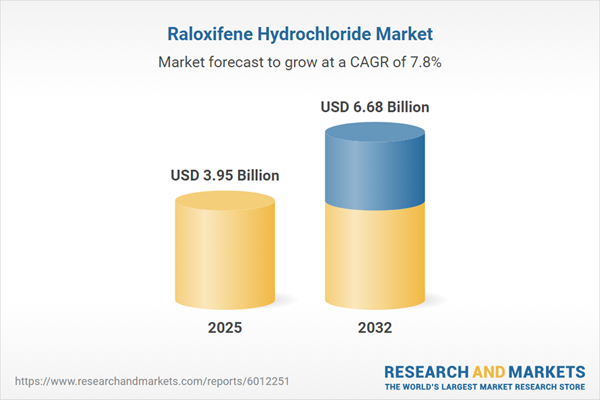Speak directly to the analyst to clarify any post sales queries you may have.
The raloxifene hydrochloride market is undergoing significant transformation as industry participants respond to evolving healthcare priorities, complex regulatory demands, and rising expectations around supply chain efficiency. For senior leaders, this environment presents both commercial risk and the opportunity to shape forward-looking strategies that sustain competitive advantage.
Market Snapshot: Raloxifene Hydrochloride Market Outlook
The global raloxifene hydrochloride market is valued at USD 3.67 billion, with forecasts projecting growth to USD 3.95 billion by 2025 and USD 6.68 billion by 2032. This expansion is fueled by a compound annual growth rate of 7.77%, primarily driven by the increasing focus on osteoporosis awareness and preventive strategies targeting breast cancer risk reduction. Market leaders are leveraging advanced clinical protocols and extending their international distribution reach, contributing to a progressively diverse competitive environment. Key differentiators include a variety of branded and generic offerings, robust partnerships within the value chain, and agile supply chain management. Maintaining compliance across varied regulatory frameworks remains central to long-term positioning and sustainable success in the raloxifene hydrochloride market.
Scope & Segmentation
- Indication: Addresses unmet needs in osteoporosis prevention and pursues opportunities to lower breast cancer risk, enabling organizations to broaden their therapeutic portfolios and support integrated care delivery.
- Type: Covers both branded and generic formulations, creating flexible pricing and procurement models that adapt to differing buyer requirements across global markets.
- Distribution Channel: Includes hospital pharmacies, retail outlets, and digital channels, maximizing patient reach and supporting scalable, omnichannel distribution approaches for healthcare providers.
- End User: Serves clinics, hospitals, and homecare providers, aligning with industry trends favoring patient-centric, decentralized healthcare solutions.
- Regions: Comprises the Americas, Europe, Middle East & Africa, and Asia-Pacific, each requiring tailored access strategies, localized compliance procedures, and custom payer engagement initiatives.
- Key Companies: Features prominent players such as Eli Lilly and Company, Teva Pharmaceutical Industries, Sandoz International, Viatris, Sun Pharmaceutical, Dr. Reddy's Laboratories, Lupin, Cipla, Aurobindo Pharma, and Hetero Labs, all recognized for resilience in operations and networked global partnerships.
Key Takeaways: Strategic Insights for Senior Decision-Makers
- Raloxifene hydrochloride supports collaborative strategies bridging bone health and oncology, allowing stakeholders to pursue new growth avenues within adjacent healthcare markets.
- The increasing number of generics and shifts in regulation make market differentiation and flexible entry strategies essential for sustainable growth in every region.
- Adoption of digital health technology and telemedicine facilitates greater patient engagement and strengthens transparency across complex distribution networks, supporting digital transformation goals.
- Payers and procurement authorities expect evidence-driven outcomes and operational transparency, making outcome-based contracting a critical avenue for achieving market access in competitive landscapes.
- Regional regulatory variability requires companies to recalibrate commercial, compliance, and partnership models to achieve effective market presence and navigate local requirements efficiently.
Tariff Impact: Navigating Trade Policy and Supply Chain Risk
As recent United States trade policy adjustments influence global supply chains for raloxifene hydrochloride, sector leaders are enhancing supplier vetting procedures and implementing proactive scenario planning. The adoption of complex sourcing and refined procurement strategies is vital to ensure consistent product availability and responsiveness to regulatory shifts worldwide.
Methodology & Data Sources
This report is based on focused monitoring of industry trends, deep regulatory analysis, and systematic reviews of clinical literature. Principal insights were derived from direct stakeholder interviews and validated through scenario-based testing to deliver actionable intelligence tailored to executive leadership needs.
Why This Report Matters
- Delivers structured frameworks for aligning strategic leadership initiatives with the dual imperatives of compliance and market competitiveness.
- Equips senior executives with resilient, scenario-driven intelligence to anticipate industry volatility and refine operational responses.
- Enables disciplined growth and improved risk control by supporting the identification of actionable opportunities in a rapidly changing market landscape.
Conclusion
This analysis delivers critical insights for senior decision-makers seeking to refine strategic direction, enhance operational agility, and reinforce organizational resilience in the evolving pharmaceutical market.
Additional Product Information:
- Purchase of this report includes 1 year online access with quarterly updates.
- This report can be updated on request. Please contact our Customer Experience team using the Ask a Question widget on our website.
Table of Contents
3. Executive Summary
4. Market Overview
7. Cumulative Impact of Artificial Intelligence 2025
Companies Mentioned
The companies profiled in this Raloxifene Hydrochloride market report include:- Eli Lilly and Company
- Teva Pharmaceutical Industries Ltd
- Sandoz International GmbH
- Viatris Inc
- Sun Pharmaceutical Industries Ltd
- Dr. Reddy's Laboratories Limited
- Lupin Limited
- Cipla Limited
- Aurobindo Pharma Limited
- Hetero Labs Limited
Table Information
| Report Attribute | Details |
|---|---|
| No. of Pages | 182 |
| Published | November 2025 |
| Forecast Period | 2025 - 2032 |
| Estimated Market Value ( USD | $ 3.95 Billion |
| Forecasted Market Value ( USD | $ 6.68 Billion |
| Compound Annual Growth Rate | 7.7% |
| Regions Covered | Global |
| No. of Companies Mentioned | 11 |









